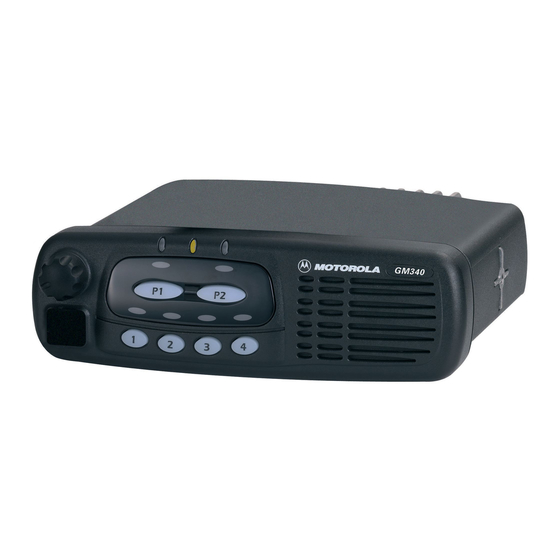- ページ 17
ラジオ Motorola GM380のPDF サービス情報をオンラインで閲覧またはダウンロードできます。Motorola GM380 32 ページ。 Gm series professional radio uhf (403-470mhz)
Motorola GM380 にも: サービス情報 (34 ページ), サービス情報 (32 ページ)

Controlhead Model for GM380, and GM1280
output of the op-amp to rise and to reduce the base to emitter voltage of Q0943. This decreases the
current of Q0941 until the loop has settled.
The back light for the LCD module uses a similar circuitry. The only differences are that µP port PH2
controls the back light brightness and that the LED's are located on the LCD module which is
connected via J0821. Control line BL A GREEN connects to the anodes and control line BL K
GREEN connects to the cathodes of the LED's.
4.8
Liquid Crystal Display (LCD)
The LCD module consists of the display and the display driver and is connected via connector
J0821. The display is a single layer super twist nematic (STN) LCD display. It has a dot matrix of 32 *
96 dots for displaying graphics and alpha - numerical information and a line with 21 pre - defined
icons above the dot matrix
The driver contains a data interface to the µP, an LCD segment driver, an LCD power circuit, an
oscillator, data RAM and control logic. At power up the driver's control logic is reset by a logic „0" via
pin 5 of J0821. The driver's µP interface is configured to accept 8 bit parallel data input (J0821-D0-
D7) from the controlhead µP (U0871 port PC0-PC7).
To write data to the driver's RAM the µP sets chip select (J0821-6) to logic „0" via U0871-26, RD
(J0821-10) to logic „1" via (U0871-40) and WR (U0821-9) to logic „0" via U0871-33. With input A0
(J0821-8) set to logic „0" via U0871-34 the µP writes control data to the driver. Control data includes
the RAM start address for the following display data. With input A0 set to logic „1" the µP then writes
the display data to the display RAM. When data transfer is complete the µP terminates the chip
select and the clock activities.
The display driver's power circuit provides the voltage supply for the display. This circuit consists of a
voltage multiplier, voltage regulator and a voltage follower. The regulator output voltage for the
display can be controlled electronically by a control command sent to the driver. The voltage level
can be measured by one of the µP's analogue to digital converters (U0871-42) via J0821-21. To
stabilize the display brightness over a large temperature range the µP measures the temperature via
analogue to digital converter (U0871-43) using a temperature sensor on the module (J0821-4).
Dependent on the measured temperature the µP adjusts the driver output voltage, and in turn the
display brightness, via parallel interface.
4.9
Microphone Connector Signals
Signals BUS+, PTT IRDEC, HOOK, MIC, HANDSET AUDIO, FLT A+, +5V and 2 A/D converter
inputs are available at the microphone connector J0811. Signal BUS+ (J0811-7) connects to the
SBEP bus for communication with the CPS or the Universal Tuner. Line MIC (J0811-5) feeds the
audio from the microphone to the radio's controller via connector J0801-4. Line HANDSET AUDIO
(J0811-8) feeds the receiver audio from the controller (J0801-6) to a connected handset. FLT A+,
which is at supply voltage level, and +5V are used to supply any connected accessory like a
microphone or a handset.
The 2 A/D converter inputs (J0811-9/10) are used for a microphone with keypad. A pressed key will
change the dc voltage on both lines. The voltages depend on which key is pressed. The µP
determines from the voltage on these lines which key is pressed and sends the information to the
host radio.
Line PTT IRDEC (J0811-6) is used to key up the radio's transmitter. While the PTT button on a
connected microphone is released, line PTT IRDEC is pulled to +5 volts level by R0880. Transistor
Q0871 is switched on and causes a low at µP port PA2. When the PTT button is pressed, signal PTT
IRDEC is pulled to ground level. This switches off Q0871 and the resulting high level at µP port PA2
2-11
